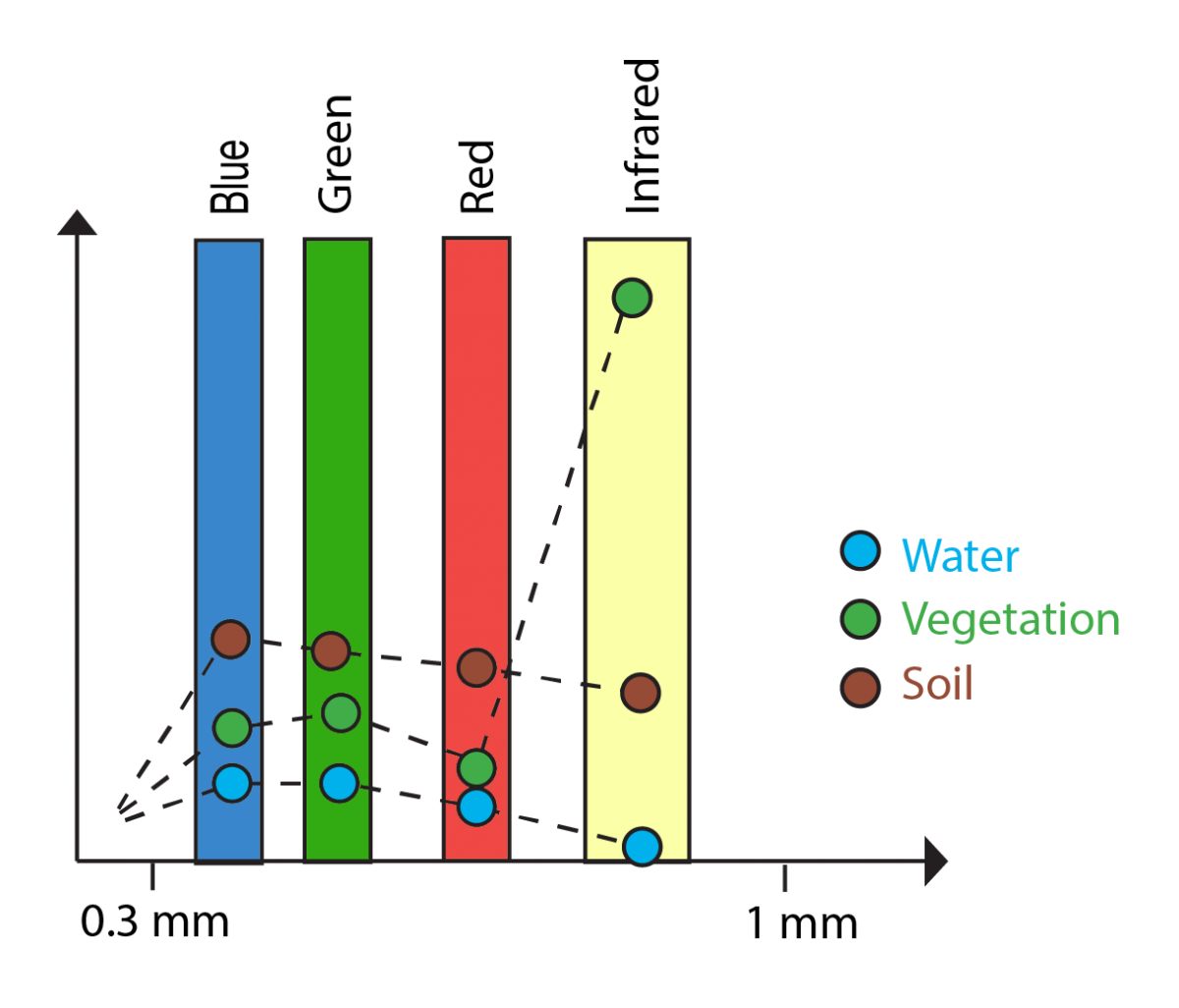Data acquisition
The electromagnetic spectrum
…over the rainbow!
The agitation of the charged particles that are present in all matter causes all objects to emit electromagnetic radiation. The objects emit this energy, but can also transmit, absorb, and reflect it. The sun is one of the main natural sources of the electromagnetic energy on Earth, but there are also many artificial sources, such as electric lamps, microwave ovens, and cell phones.
Electromagnetic radiation consists of a range of waves, each determined by its frequency (ν) or wavelength (λ), which are interrelated (ν = v/λ, where v is the propagation speed of the waves in the studied environment).
The sun’s electromagnetic spectrum includes radiation with very short wavelengths, such as gamma rays and X-rays (of the order of 1/100 of a micron) and very long wavelengths, such as radio waves (that can be several kilometres long). A relatively small part of the electromagnetic spectrum is especially important for us.
This is the part that covers wavelengths from 0.4 to 0.7 µm, or visible light. Within this frequency range each of the colours of the rainbow corresponds to a specific wavelength. Thus, blue = approx. 0.45µm, green = approx. 0.55µm, and red = approx. 0.65µm.


Electromagnetic radiation’s characteristics can undergo changes during transmission. For example, the Earth’s atmosphere (notably the ozone layer) luckily blocks some of the solar radiation that is extremely harmful to human beings. The radiation’s properties are sometimes changed partially during the transfer. Thus, the ocean’s upper layers absorb the parts of the solar radiation that correspond to red and green light, which explains the blue colour of the deeper layers. At a certain depth the water absorbs all of the visible light rays and the ocean becomes pitch black.
When radiation reaches an object, the object may absorb one part and reflect another part of the radiation. In all cases, the electromagnetic radiation’s characteristics will be modified. Plants use mainly the red part of the solar spectrum to carry out photosynthesis. The reflected light spectrum is thus devoid of this red band and the light reflected by the leaves appears green.
Objects’ ‘spectral signatures’ can be represented graphically as shown here, with the reflected electromagnetic radiation’s frequencies (or wavelengths) plotted on the abscissa (x axis) and intensities on the ordinate (y axis).
As we can see from the graph, different objects do not all absorb the same parts of solar radiation. Consequently, their reflected ray spectra are different. The pattern of the electromagnetic spectrum reflected by an object is called its ‘spectral signature’.
Remote sensing makes use of this property, for analysing the characteristics of the electromagnetic spectra reflected by objects (their spectral signatures) allows one to determine some of the objects’ properties, within limits. Human vision basically uses the same principle: it uses colours to identify objects, for example, to select the ripest apple. The sensors used in remote sensing, however, make it possible to broaden the field of analysis to include parts of the electromagnetic spectrum that are well beyond visible light.
A spectro-radiometer is usually used to analyse all the details of an electromagnetic spectrum. This instrument can analyse all of the frequencies of a given electromagnetic radiation. Other, simpler, instruments measure only certain parts of the frequency spectrum, known as spectral bands. Although the data provided by such multispectral radiometers are discrete, that is, non-continuous, they can also be used to distinguish different types of materials.The sensors used in remote sensing cover the ultraviolet (<0.3 µm), visible (0.4-0.7 µm), near-infrared (0.7-1.5 µm) and thermal infrared (up to 1000 µm or 1 mm) ranges. As a rule, they merely measure and analyse the radiation reflected by the objects that are lit by the sun; they are thus ‘passive systems’. Other remote sensing systems send out signals that strike the Earth’s surface and then analyse their echoes; these are ‘active systems’. The latter usually operate in the microwave or radar wave range, working with wavelengths of from 1cm to 1m.

